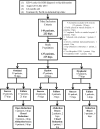Higher Pavlik Harness Treatment Failure Is Seen in Graf Type IV Ortolani-positive Hips in Males
- PMID: 26975383
- PMCID: PMC4925409
- DOI: 10.1007/s11999-016-4776-5
Higher Pavlik Harness Treatment Failure Is Seen in Graf Type IV Ortolani-positive Hips in Males
Abstract
Background: Patients with developmental dysplasia of the hip (DDH) whose hips are dislocated but reducible (Ortolani positive) are more likely to experience Pavlik harness treatment failure than are patients with dysplastic and reduced but dislocatable (Barlow positive) hips. However, data regarding factors associated with failure are limited and conflicting.
Questions/purposes: We asked: (1) What is the frequency of Pavlik harness treatment failure among Ortolani-positive hips, Barlow-positive hips, and dysplastic hips? (2) What are the factors predictive of failure of Pavlik harness treatment for Ortolani-positive hips?
Methods: In this retrospective study we identified 150 patients who underwent the Pavlik harness method for treatment of DDH between August 2011 and July 2015. Six patients initially treated at an outside facility, four patients with associated conditions, and three who pursued treatment elsewhere were excluded. A total of 137 patients (215 hips) with a median age at the time of Pavlik placement of 30 days (range, 4-155 days) were included. Of the 215 hips, 78 (36.3%) were Ortolani positive, 60 (27.9%) were Barlow positive, and 77 (35.8%) were stable, with the diagnosis of dysplasia made on ultrasound. All patients were treated with the Pavlik harness method. The primary outcome was failure of the Pavlik harness to achieve and maintain concentric hip reduction assessed by examination and ultrasound. All patients were followed after completion of Pavlik treatment for a minimum of 2 months (mean, 3 months; range, 2-4 months). In addition, 90% (122 of 137) of the patients were followed for a minimum of 6 months. Patient-specific data including family history, breech versus cephalic presentation at birth, age, sex, laterality, and hip abduction were recorded. Ultrasound data at the time of diagnosis included Graf classification, alpha angle, and percentage of femoral head coverage.
Results: The Pavlik harness method failed in 27% (21 of 78) of hips that were Ortolani positive, 8% (six of 77) with dysplasia, and 5% (three of 60) that were Barlow positive. After controlling for potential confounding variables, such as range of hip abduction, male sex (adjusted odds ratio [OR], 6.9; 95% CI, 2.0-24.2; p = 0.002) and Graf Type IV ultrasound classification (dislocated hip with alpha angle less than 43° and labrum displaced downward) (OR, 4.4; 95% CI, 1.3-15.4; p = 0.019) were identified as independent predictors of failure of Pavlik treatment among Ortolani-positive hips.
Conclusions: Ultrasound imaging of the hip should be part of the initial assessment for Ortolani-positive hips, as the ultrasound classification was found to have prognostic implications. Parents of male infants with Graf Type IV hips should be counseled regarding the higher risk of Pavlik failure. Future well-designed prospective controlled studies are necessary to establish whether alternative strategies to the Pavlik harness might improve the early outcomes of DDH in males with Graf Type IV hips.
Level of evidence: Level III, therapeutic study.
Figures


Comment in
-
CORR Insights (®) : Higher Pavlik Harness Treatment Failure Is Seen in Graf Type IV Ortolani-Positive Hips in Males.Clin Orthop Relat Res. 2016 Aug;474(8):1855-6. doi: 10.1007/s11999-016-4865-5. Epub 2016 May 6. Clin Orthop Relat Res. 2016. PMID: 27154531 Free PMC article. No abstract available.
References
-
- Borges JL, Kumar SJ, Guille JT. Congenital dislocation of the hip in boys. J Bone Joint Surg Am. 1995;77:975–984. - PubMed
-
- el-Shazly M, Trainor B, Kernohan WG, Turner I, Haugh PE, Johnston AF, Mollan RA. Reliability of the Barlow and Ortolani tests for neonatal hip instability. J Med Screen. 1994;1:165–168. - PubMed
Publication types
MeSH terms
LinkOut - more resources
Full Text Sources
Other Literature Sources
Research Materials

